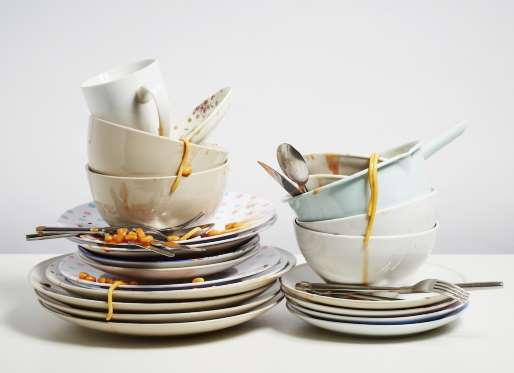DON’T WAIT
Whether you do them by hand or run them through the dishwasher, deal with the dishes right after the meal is over, so food doesn’t dry out and stick to your pots, pans, plates, and cutlery. A little rinse now will save you from scraping and scrubbing caked-on gunk later.

BLEND UP SOME SOAP
With their sharp blades and tiny crevices, blenders and food processors are a challenge to clean. To dislodge food that’s stuck around and underneath the blades, first run a bit of soapy water through the blender on the pulse setting to give the cleaning process a head start.

MAKE USE OF PLASTIC BINS
Contain yourself—or at least your dishes—when you’re on after-dinner cleaning duty. Instead of putting dirty dishes directly in the sink, put them in a plastic bin. Place the container on the countertop or, if it’s small, inside the sink, so you can keep all or part of the sink clear for other tasks until you can tackle the dishes. Putting hot water and a little soap in the bin will give your dirtiest items an instant presoak.

BAG IT
Tiny items, such as bottle tops, cocktail forks, and kids’ toys and pacifiers, can get lost in the wash cycle if they’re placed in the silverware basket or upper rack. Instead of throwing such items directly in the washer, first pop them in a laundry bag. The mesh bag will keep them from getting tossed around—or worse, lost—inside your appliance. Place the bag on the top rack when you run a load for best results.

USE A SOAP DISPENSER
Buying dishwashing liquid in bulk is a money saver, but large bottles are not easy to handle—especially with wet hands. Keep a refillable dish detergent dispenser on the counter by the sink, and leave your bulk bottle under the sink for refills. Soap will be just a quick squeeze away anytime you need it.

DON’T RINSE YOUR PLATES!
Scrape your plates but don’t rinse them before loading the dishwasher. The small food particles left behind on your dishes actually act as an aggregate that helps get dishes cleaner as they run through the wash cycle.

FLIP-FLOP YOUR FORKS AND SPOONS
When loading the dishwasher, be sure to alternate the position of flatware (placing some with handles up and some with handles down) so that forks and spoons don’t nest together. Sharp knives, if you put them in the dishwasher, should always go handles up—for obvious safety reasons.

PRESORT YOUR FLATWARE
Sort your flatware as you load the dishwasher, putting all the forks in one bin, all the spoons in another. Presorting your utensils doesn’t add much time to your dishwashing routine, and it saves time later when you put the dishes away.

CLEAN WHILE YOU’RE COOKING
Wash your pots and pans as you finish your cooking tasks. Food residue wipes off much more easily if the cookware is still warm, and you’ll have fewer things to clean after the meal is over.

USE COLD WATER FOR DAIRY AND STARCH
It may seem counterintuitive, but using cold water (not hot) to clean that lasagna pan will make the work go faster. That’s because hot water makes dairy and starch stickier, and harder to wash away.

MAKE AN EXTRA DRYING RACK
Short on counter space but in need of an additional spot to dry your dishes? You can make an extra drying rack by placing a cooling rack on one half of a double sink. Not only will this hack double your dish-drying area, but because the clean dishes will drip right over the drain, your counters will stay dryer.

CLEAN IN THE RIGHT ORDER
Yes, there actually is a right and wrong way to hand-wash dishes. You should go from cleanest to dirtiest. Wash glasses first to ensure that grease doesn’t get transferred onto them. Then wash flatware and plates that have been scraped clean, and last, pots and pans. Do you have a dirty cast iron pan to tackle? Clean it last—after you’ve rinsed the dish soap out of the sink.













